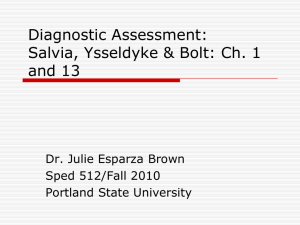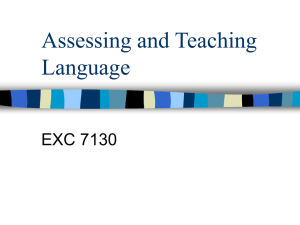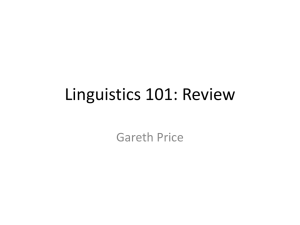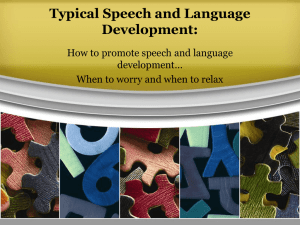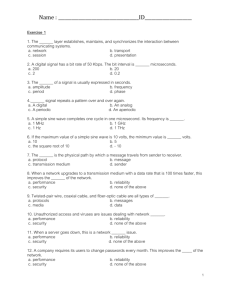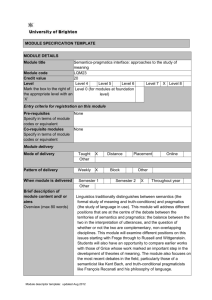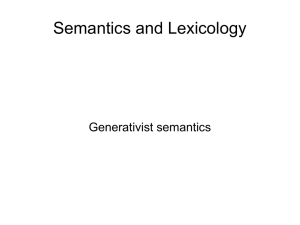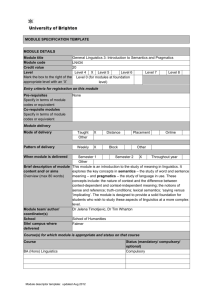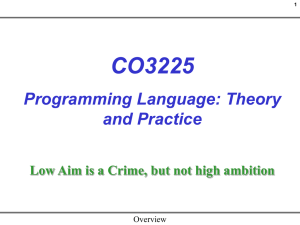ORAL LANGUAGE TEST BANK
advertisement
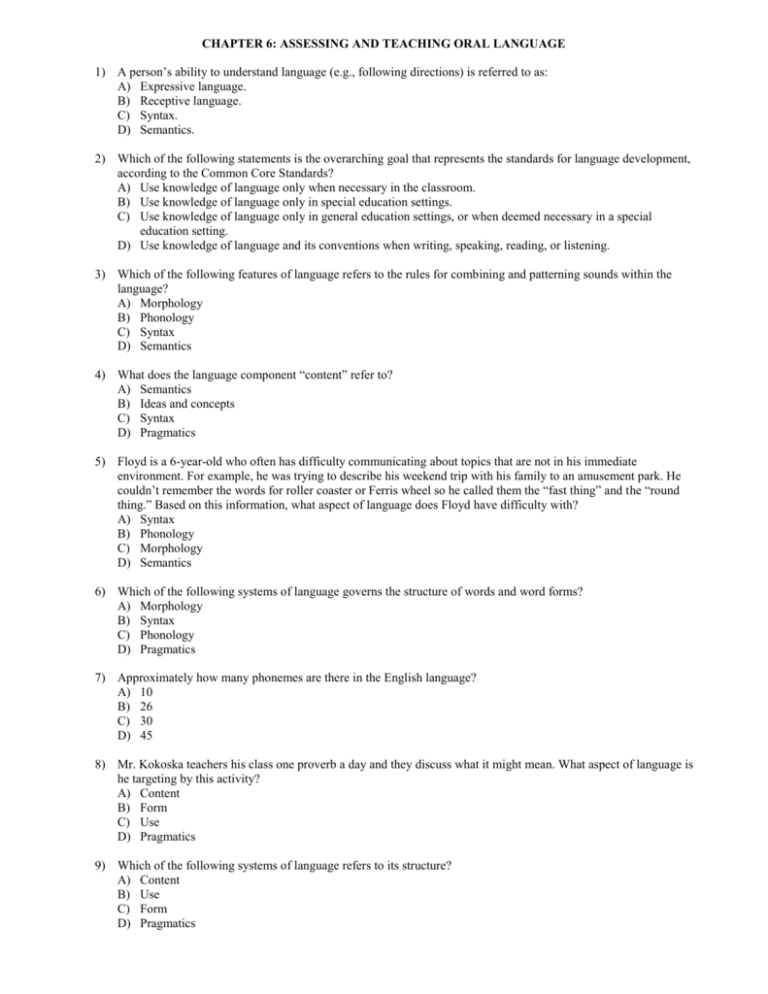
CHAPTER 6: ASSESSING AND TEACHING ORAL LANGUAGE 1) A person’s ability to understand language (e.g., following directions) is referred to as: A) Expressive language. B) Receptive language. C) Syntax. D) Semantics. 2) Which of the following statements is the overarching goal that represents the standards for language development, according to the Common Core Standards? A) Use knowledge of language only when necessary in the classroom. B) Use knowledge of language only in special education settings. C) Use knowledge of language only in general education settings, or when deemed necessary in a special education setting. D) Use knowledge of language and its conventions when writing, speaking, reading, or listening. 3) Which of the following features of language refers to the rules for combining and patterning sounds within the language? A) Morphology B) Phonology C) Syntax D) Semantics 4) What does the language component “content” refer to? A) Semantics B) Ideas and concepts C) Syntax D) Pragmatics 5) Floyd is a 6-year-old who often has difficulty communicating about topics that are not in his immediate environment. For example, he was trying to describe his weekend trip with his family to an amusement park. He couldn’t remember the words for roller coaster or Ferris wheel so he called them the “fast thing” and the “round thing.” Based on this information, what aspect of language does Floyd have difficulty with? A) Syntax B) Phonology C) Morphology D) Semantics 6) Which of the following systems of language governs the structure of words and word forms? A) Morphology B) Syntax C) Phonology D) Pragmatics 7) Approximately how many phonemes are there in the English language? A) 10 B) 26 C) 30 D) 45 8) Mr. Kokoska teachers his class one proverb a day and they discuss what it might mean. What aspect of language is he targeting by this activity? A) Content B) Form C) Use D) Pragmatics 9) Which of the following systems of language refers to its structure? A) Content B) Use C) Form D) Pragmatics 10) Which of the following language components are included under “form”? A) Syntax, morphology, and phonology B) Content, semantics, and use C) Pragmatics, phonology, and semantics D) Grammar, vocabulary, and intonation 11) Which of the following definitions best describes a morpheme? A) The smallest unit of sound that differentiates meaning. B) The smallest unit of language that conveys meaning. C) A rule that governs phoneme order. D) A rule that governs word order. 12) A six-year-old says “bis” for “fish,” “bi” for “fine,” and “bi” for “five.” He most likely has a deficit in which area of language? A) Syntax B) Phonology C) Morphology D) Semantics 13) “Un” as in unhappy and “-ed” as in walked are examples of: A) Morphemes. B) Phonemes. C) Words. D) Pragmatics. 14) In the Italian language, “gn” can form a letter combination at the beginning of a word (“gnocchi”) whereas in English, this letter combination never occurs at the beginning of a word. This example illustrates a difference between Italian and English: A) Morphology. B) Semantics. C) Pragmatics. D) Phonology. 15) How does the words “bat” and “cat” differ? A) By one morpheme B) By one phoneme C) In syntax D) In form 16) Which of the following is NOT a morpheme? A) Cat B) Pretty C) -est D) Ch 17) Which of the following components of language refers to the purposes or functions of communication, or how we use language to communicate? A) Semantics B) Phonology C) Grammar D) Pragmatics 18) Mrs. Pollock writes sentences on sentence strips and then cuts out the words. She then asks her students to put the words in order to form correct sentences. This activity focuses primarily on which aspect of language? A) Syntax B) Pragmatics C) Semantics D) Use 19) Mrs. Garrison teaches her third graders to ask each other questions. She instructs them to find out information about each other by conducting an interview. She starts by having them ask open-ended questions and then closed questions. What aspect of language is she targeting in this activity? A) Semantics B) Vocabulary C) Phonology D) Pragmatics 20) Which of the following choices represents the basic syntactical structure for English? A) Subject + object + verb B) Verb + object + subject C) Subject + verb + object D) Verb + subject + object 21) In Spanish, the noun is often placed before the adjective. In English, the adjective is always before the noun. This example illustrates: A) A pragmatic difference between the two languages. B) A morphological difference between the two languages. C) A syntactic difference between the two languages. D) BICS. 22) Which of the following factors is NOT an influence on pragmatics? A) The listener’s knowledge of the topic B) The circumstances C) The method of communication used D) The age of the listener 23) Al is a seventh grader who loves to talk to people. He often approaches other students and abruptly starts talking about his computer game collection. When the child takes a turn in the conversation (e.g., “I’ve got a computer game collection too!”), Al does not seem to hear and continues to talk about his own collection. He includes a lot of detail about specific computer games and does not seem to notice when his conversational partner gets bored or walks away. Al has difficulty with: A) Content. B) Pragmatics. C) Form. D) Semantics. 24) A student who has word-finding problems has difficulty with what aspect of language? A) BICS B) Use C) Content D) Form 25) Figurative language includes which of the following components of language? A) Similes B) Syntax C) Nouns D) Adjectives 26) The different uses of the word “running” in the two sentences below are representative of which component of language? Bob is running for office. Bob is running a marathon. A) Syntax B) Phonology C) Semantics D) Pragmatics 27) Sheila is a third grader who often uses nonspecific words (e.g., thing, stuff) for specific words. Sheila most likely has a: A) Word-retrieval problem. B) Receptive language delay. C) Pragmatic deficit. D) Phonic deficit. 28) Throughout school-age years, students become more empathetic toward their conversational partner and are better able to understand a variety of perspectives. This is an increase in: A) Language pragmatics. B) Language form. C) BICS. D) CALP. 29) Which of the following would be a language skill that is too advanced for a 6-year-old? A) Asking others for information B) Expressing affection appropriately C) Expressing hostility appropriately D) Making deliberate use of metaphors 30) When planning a language program for students with delayed language skills, begin by: A) Adhering closely to a language curriculum. B) Determining what knowledge and skills a student has already acquired. C) Focusing on receptive language before expressive language. D) Focusing on expressive language before receptive language. 31) When working with culturally and linguistically diverse students, which of the following strategies would NOT be representative of an effective teacher? A) Having high expectations of their students B) Seeing themselves as a member of the community C) Displaying a sense of confidence in their ability to succeed with students who are culturally and linguistically diverse D) Reminding students that the classroom is no place for their first language and discouraging its use in school 32) Ms. Volpe is working with a third grader who is an ELL and has difficulty forming complex sentences and causal structures. The third grader said, “I didn’t arrive school on time. The bus was late.” Ms. Volpe says, “Oh, you didn’t arrive to school on time because the bus was late.” What technique is she using to assist this third grader? A) Self-talk B) Expansion C) Chunk information D) Slow pacing 33) When working with students with literacy and language difficulties, a speech-language teacher may do all of the following strategies EXCEPT: A) Collaborate with classroom teachers to implement developmentally appropriate language arts and literacy programs. B) Assist in modifying and selecting language and instructional strategies that integrate oral and written communication skills. C) Withhold information on students’ progress from other school personnel so as not to influence their opinions of the students. D) Provide information and support for parents of at-risk children regarding language and literacy activities in the home environment. 34) All of the following ideas are things speech and language therapists do to promote RTI in their schools EXCEPT: A) Explain the role of language in curriculum and instruction. B) Provide research-based knowledge on language screening and assessment. C) Take exclusive control in identifying screening measures. D) Provide professional development on language. 35) When working with students with difficulties with social-emotional communication skills, a speech-language teacher may do all of the following strategies EXCEPT: A) Provide information regarding the link between social-emotional problems and social communication skills. B) Assist in training school staff to use effective verbal and nonverbal communication strategies in conflict resolution. C) Demonstrate lessons to enhance pragmatic communication skills. D) Adopt the role of a special education teacher and coteach in the general education classroom. 36) When working with families to extend language concepts, all of the following are suggestions for using newly learning language concepts at home EXCEPT: A) Encourage parents/guardians to ask open-ended rather than closed questions about their child’s school day. B) Discourage families from reading books to their children and instead focus on real-life conversations. C) Encourage parents/guardians to use new vocabulary words at home for the child to share at school. D) Have students ask their families about hypothetical situations to practice asking questions and listening skills. 37) Teachers use a variety of strategies to make learning English easier for culturally and linguistically diverse students. Which of the following choices would NOT be one of those strategies? A) Simplify language, but continue to use more complex language as the students’ understanding progresses B) Never repeat spoken instructions or key ideas in order to increase their listening comprehension C) Adapt materials without watering down the content D) Include both language development and content vocabulary development 38) Which of the following statements about working with families to extend language concepts is NOT true? A) Children are more likely to learn new vocabulary and language structures when they are active participants in their learning and can practice new concepts in different contexts. B) Keep all language activities short and fun so that parents/guardians do not view communication as homework. C) When planning language activities, it is important to be aware of cultural and linguistic differences in the home. D) If a family does not speak English, encourage the student to complete these activities at a friend’s house instead of completing them in the language used at home. 39) Mrs. Moore’s class was learning about the skeletal system and discovered where the smallest bone in the body is located. Students were instructed to ask their parents if they knew where it was. This is an example of A) Response to intervention. B) Using newly learned language concepts in a variety of environments. C) A scavenger hunt. D) Second language acquisition. 40) Mr. Hinton creates a barrier game for his students to work in pairs. Each pair sits facing each other with a barrier (large piece of cardboard) between them. One student has a picture and the other student has a blank piece of paper. The student with the picture has to describe it while the other student draws. Which of the following choices would NOT be considered a language goal for this activity? A) Listening to directions B) Asking for clarification C) Giving directions D) Forming complete sentences 1) Name some effective strategies to consider when presenting a new language concept or skill. 2) Explain expansion and elaboration and how they are used. 3) What are some important considerations to keep in mind when providing instruction for students who speak English as a second language? 4) Mr. Tamberion is a first-grade teacher who has several students with language difficulties in his classroom. What are two activities that parents can do with their child to assist their children in expanding their vocabulary knowledge?
